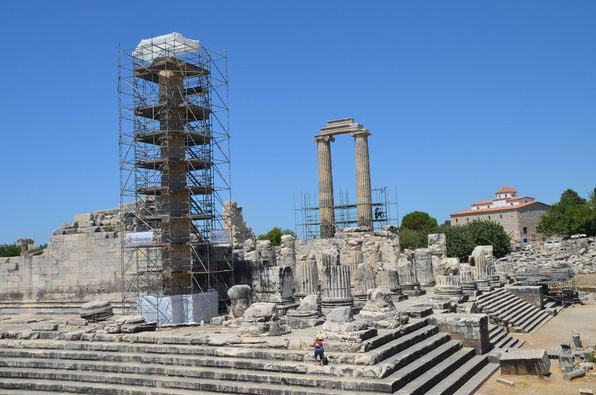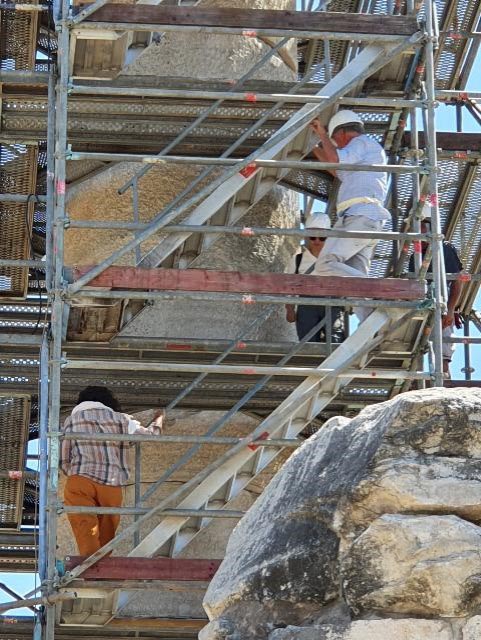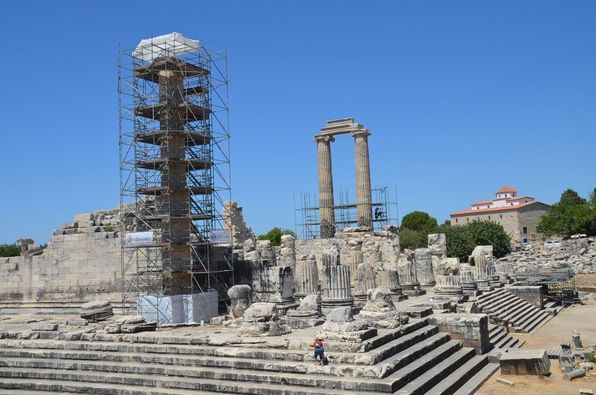With some jousting from the Ses Gazette and Voices, I found myself back at the Temple observing what was claimed to be restoration of the pillars, writes Glenn Maffia.
A Turkish team of archaeologists will, probably by this time next year, replace the team from the German Archaeological Institute for the care and maintenance of the entire site. There are a number of factors as to why, which I, unfortunately, do not have space to go into depth here.

Upon my visit, I noticed only senior figures from the German team; there were none of the younger graduates one normally notices. I certainly saw the German technical engineer climbing the scaffolding ladders of the single column with three other persons unknown to me.
He was showing and pointing to the stress fractures and general weathering of the spaces between the column drums. These are points that always concentrate the attention of the archaeologists whenever they arrive in Didyma.
Unfortunately, those times have been rather hit and miss in recent years due to various circumstances, which may be just one of the reasons for this ‘Change of Guard’ which I penned just a week or so ago.
I have not seen them go so high previously, but they regularly pay a lot of attention to the lower column drums. The highest I have seen maintenance work has been approximate to the height of the present-day outer walls, around 2013-2014.
Restoration or Maintenance
Local media misinterpreted the word ‘restoration’. Restoration means, in this case, the rebuilding of something which has been critically damaged or, indeed, destroyed; such as the Library of Celsus at Ephesus (for an example which may be familiar with all readers).

As an aside I am rather sceptical about the amount of restoration that many Turkish archaeologists do undertake. I believe that this action is seriously impaired by the validity of much of our information and that once restored physically it is exceedingly difficult, if not impossible, to unravel the mess into a correct and coherent whole.
Anyway, there is no need for a physical restoration we have sophisticated 3D computer graphics now. There is just a matter of adding newly found data into the computer program to generate a new advanced representation, leaving the original structure untouched by interfering hands.
We do have examples of German archaeologists being seduced by this need to rebuild. The aforementioned Library of Celsus was painstakingly reassembled by Volker Michael Strocka between 1970 and 1978.
Also, here in Didyma we can see beside the Sacred Road the reconstructions of the shops which once lay next to the culmination of the road, I believe these were realised in the ’60s or ’70s.
Though in more recent years I have never known of any restorations being imposed on us by the archaeologists, what they predominantly perform are extensive maintenance/ preservation works. And it was precisely this which I witnessed when visiting the site the other day.
Accurate history
The local media stated the Temple was constructed in the 6th century BC (we actually term that dating as BCE these days; Before Common Epoch). Indeed there was a temple that was begun during that period, but not the one we predominantly see today. Here, this is referring to the Archaic temple which was severely damaged by the Persian army following the Ionians (Greek) defeat at the naval battle just off of the islands of Lade, close to Miletus, in 494 BCE.
The temple we predominantly see today is the Hellenistic temple, which was instigated after Alexander the Great had swept the Persians from this land during 334 BCE.
The construction of this Hellenistic temple commenced some 30 years after this date and was designed at inception by Paionias and Daphnis, two renowned architects of the day.
This wonderful edifice became the second or third most important sanctuary to Apollo; behind Delphi on mainland Greece, but vying with Claros, a little further north from here, for the prestige of the ‘silver medal’ position.
I trust that has sorted out the history with a little more clarity.
